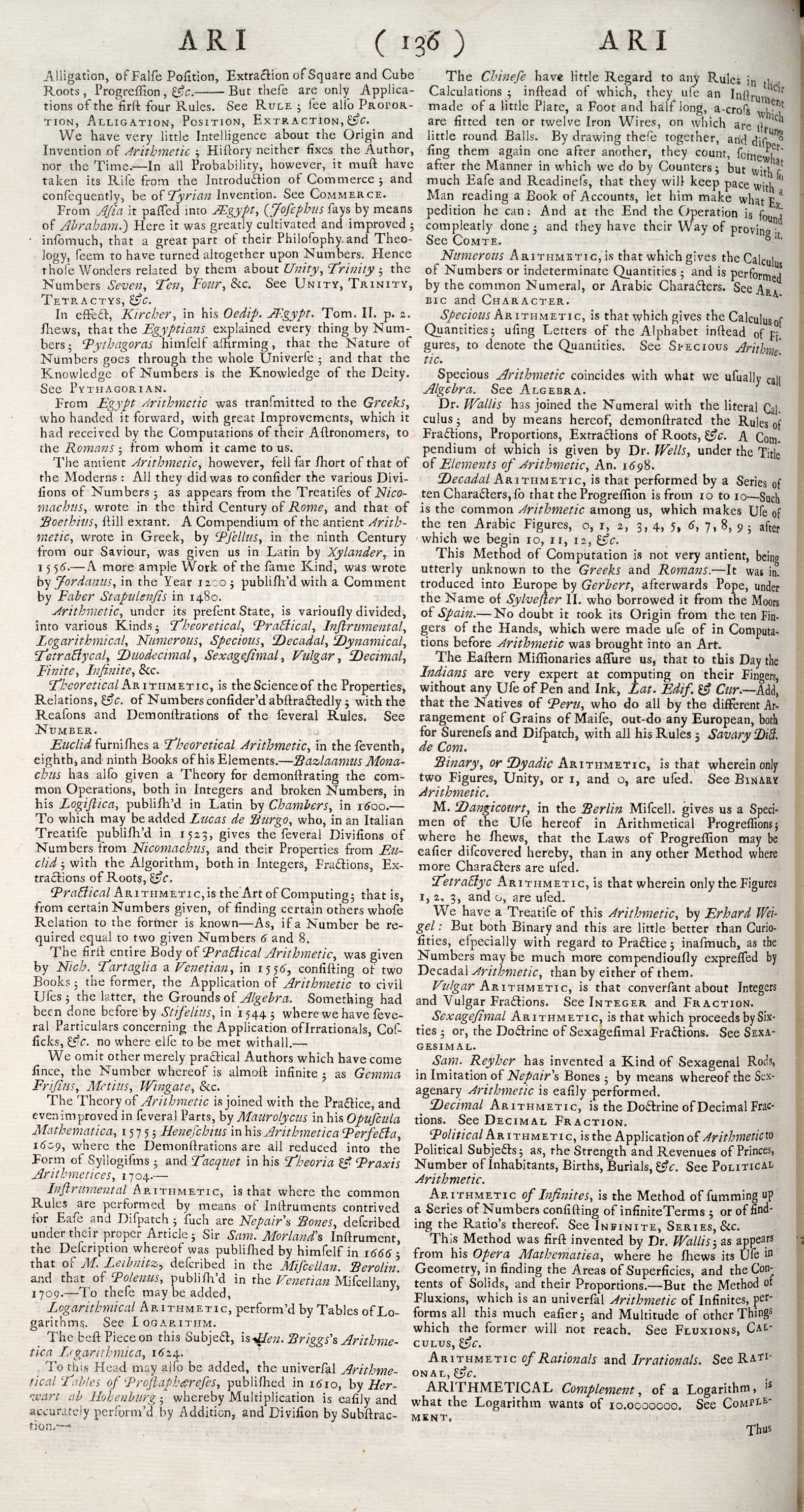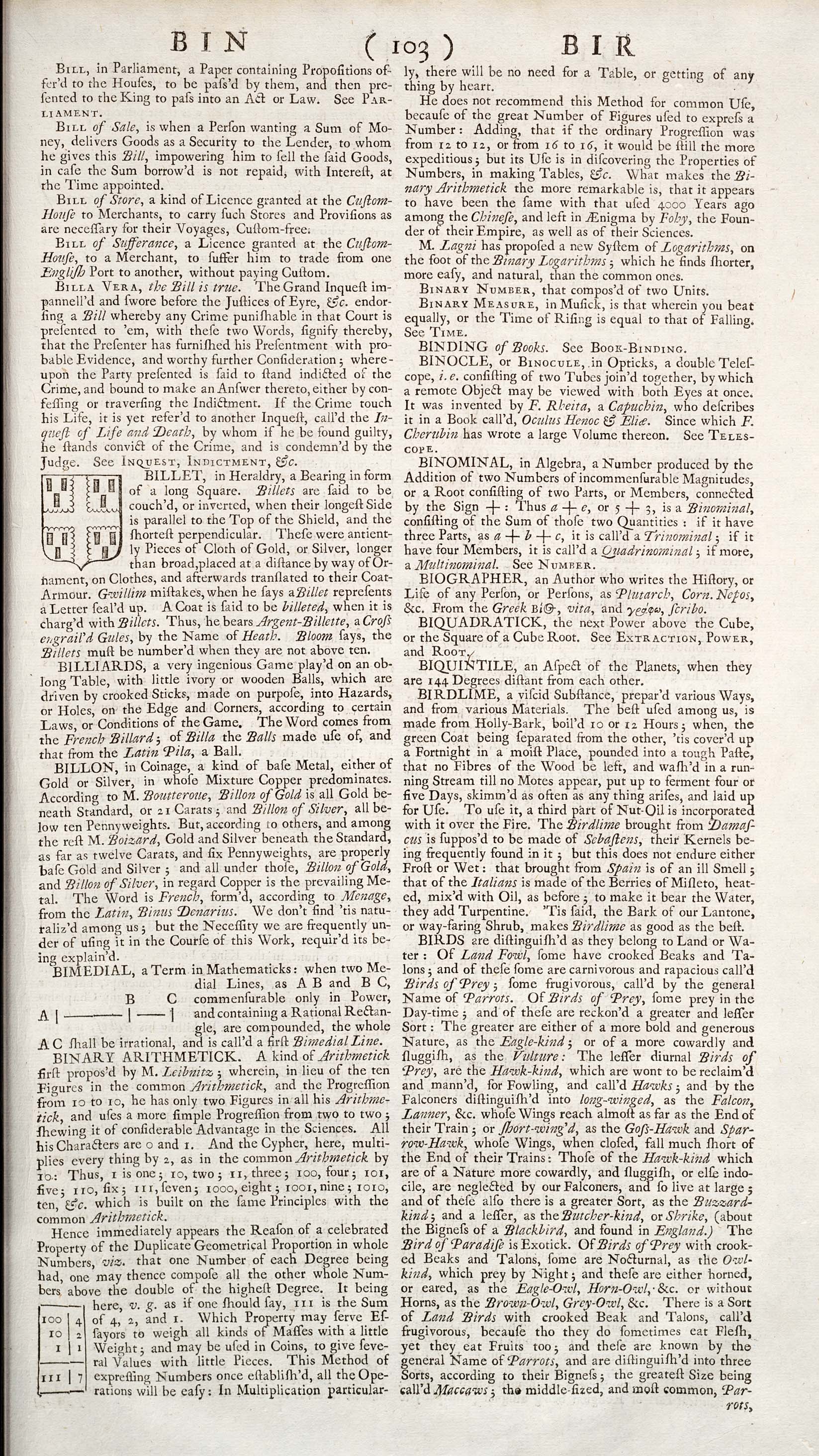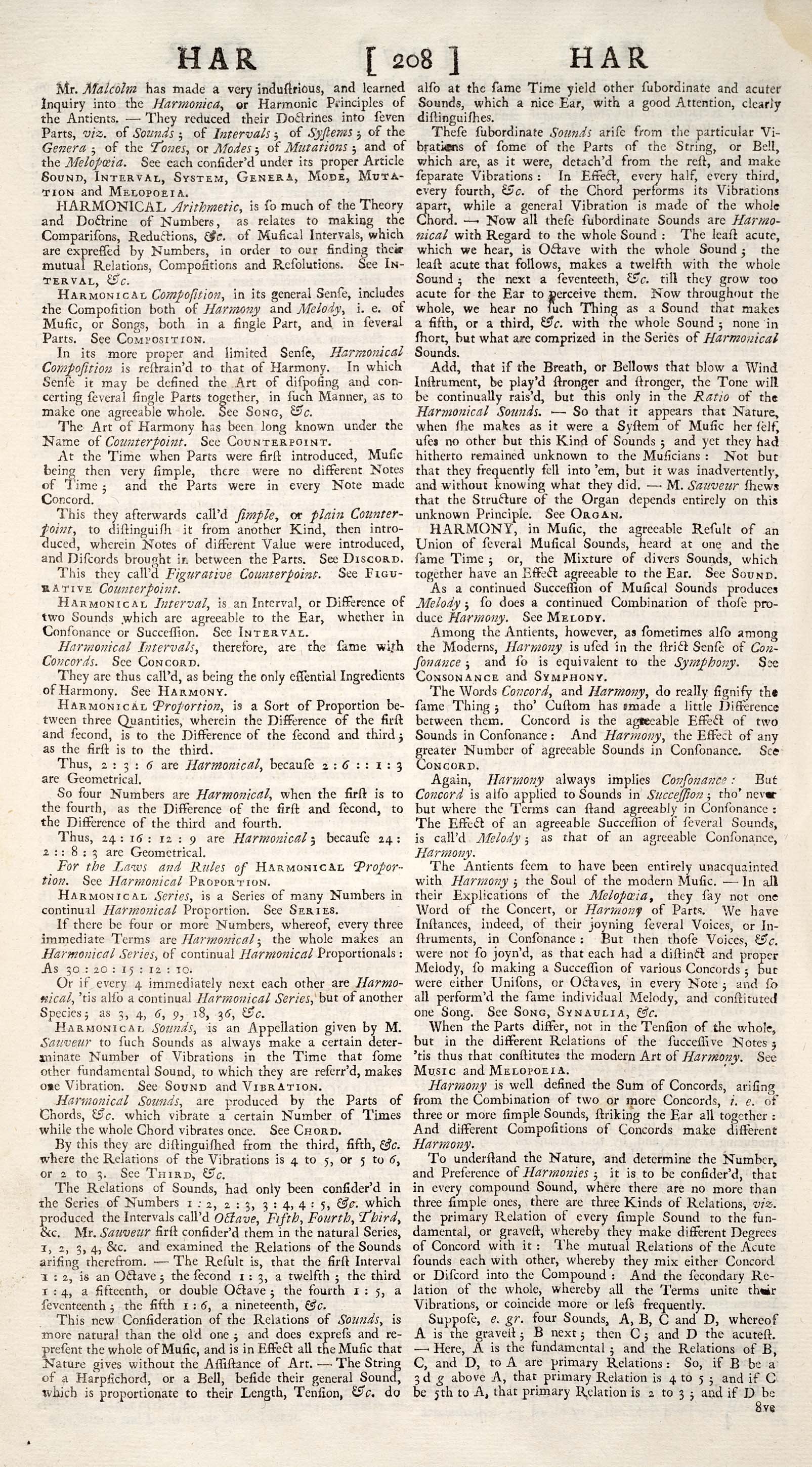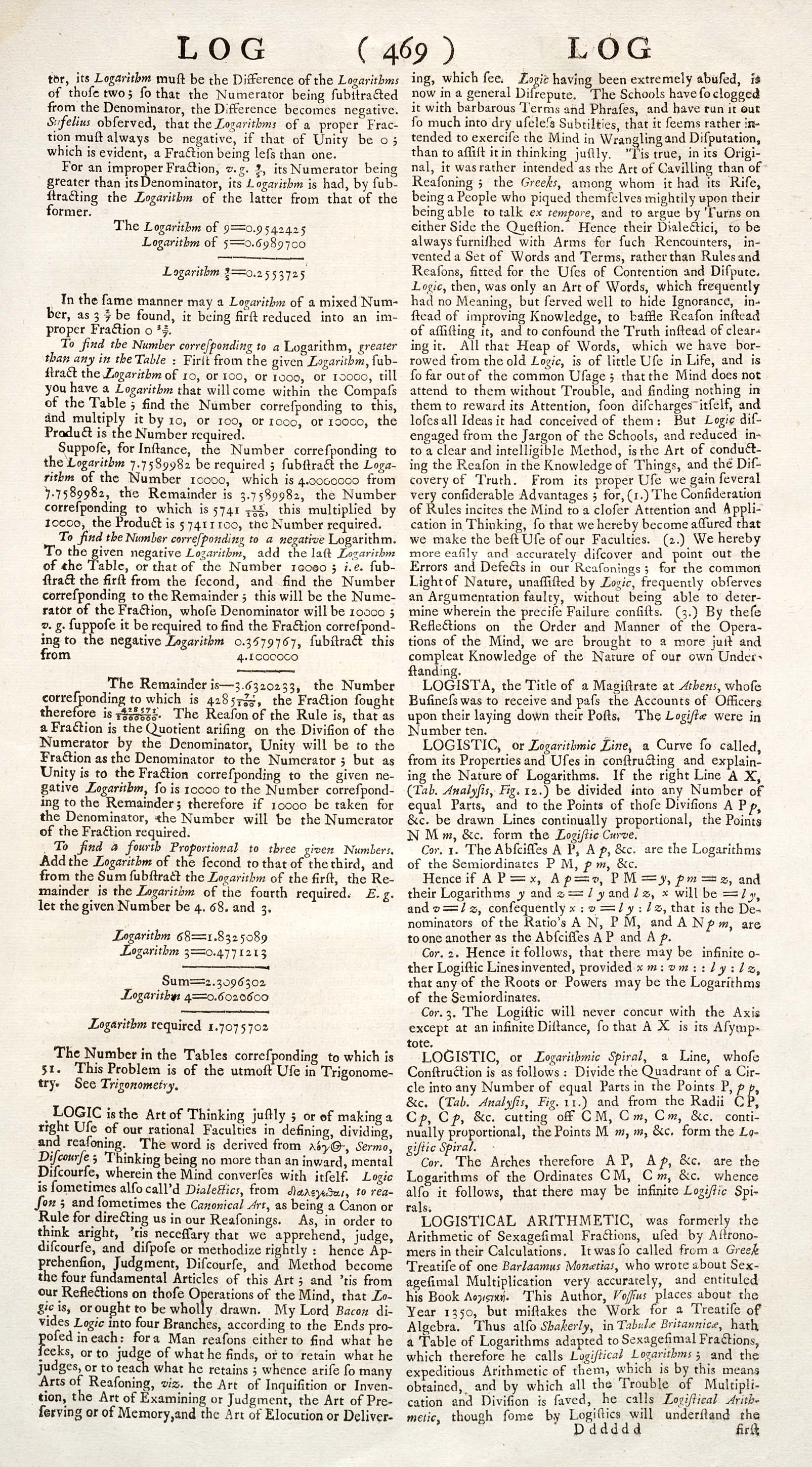In this Sense Livy, describing the Luxury into which the Romans degenerated after the Conquest of Asia, says, They had their Abaci, Beds, &c. plated over with Gold. Dec. IV. Lib. ix.
The Word is Latin, but form'd from the Greek,
ALLIGATION, in Arithmetic, a Rule or Operation, whereby Questions are resolved, relating to the Mixture of diverse Commodities or Ingredients together, with the Value, Effect, &c. thereof. See RULE, MIXTURE, etc. The Word is formed of the Latin alligare, to tie together; by reason, perhaps, of a sort of Vincula, or circular Ligatures, ordinarily used to connect the several Numbers together. Alligation is of two Kinds, Medial and Alternate. Alligation Medial, is when from the several Quantities and Rates of diverse Simples given, we discover the mean Rate of a Mixture compounded out of them. The several Cases hereof, will come under the following Rules. The Quantity of the Ingredients, and the Prices of each being given; to find the Price or Value of some part of the Mixture. Multiply the Ingredients severally by their own Prices, and divide the Sum of those Products by the Sum of the Ingredients; the Quotient answers the Question. The Prices of the several Ingredients, and the Sum paid or received for the Mixture being given; to find what quantity of each was bought or sold. Divide the Sum paid or received, by the Sum of the particular Prices; the Quotient is the Answer. The Ingredients of a Mixture being given, to augment or diminish the Mixture proportionally—Sum up the Ingredients; then say, As that Sum is to the Augmentation or Diminution, so is the Quantity of each Parcel of the Mixture, to the Quantity of the Mixture desired. The Nature, Quality, &c. of the several Ingredients of a Mixture being given, to find the Temperament or Degree of Fineness resulting from the Whole.—Place the several Quantities of the Mixture in Rows; against which place orderly their several Qualities of Fineness; and multiply each Quantity by its own Quality or Degree of Fineness: then, as the Sum of the Quantities is to their Products, so is Unity, to the Quality or Fineness of the Mixture. The Quantities of a Mixture being given; to find the particular Quantities of any Ingredient in any part of the Mixture. If the Mixture be of only two Things, say, As the Total of the Ingredients in the Composition, is to the Part of the Mixture proposed; so is the Quantity of the Ingredient proposed in the whole Composition, to the Quantity of the Ingredient in the Part desired—If the Mixture consist of more Ingredients, repeat the Work for each. Given the Total of a Mixture, with the whole Value, and the Values of the several ingredients, , to find the several Quantities mixed, though unequally. See the Total of the Mixture by the least Value, subtract the Product from the total Value; and the Remainder is the first Dividend. Then take the said least Value from the greatest valued Ingredient, and the Remainder is the first Divisor. The Quotient of this Division shows the Quantity of the highest-priced Ingredient, and the other is the Complement to the Whole. And when more Ingredients than two are in the Composition, the Divisors are the several Remains of the least Value, taken from the other. The Dividends are the Remains left upon the Divisions, till none remain there; which will be one short of the Number of Ingredients: and this defective Ingredient is to be supplied as a Complement; and in Division, no more must be taken in every Quotient, than that there may remain enough for the other Divisors; and the last to leave nothing remaining. See DIVISION. Alligation Alternate, is when the Rates or Qualities of divers Simples are given; and the Quantity of each is required necessary to make a Mixture of the given Rate or Quality. Alligation Alternate, shows the due Proportion of several Ingredients; and counter-changes the Places of such Excesses or Differences as arise between the mean Price and the Extremes; ascribing that to the greater Extreme, which proceeds from the lesser; and contrarily. The Rules which obtain in Alligation Alternate, are as follow. Every greater Extreme to be linked with one lesser. If either of the Extremes be single, and the other Extreme plural; the single Extreme to be linked to all the rest. If both greater and lesser Extremes be not plural, they may be linked so diversely, that several Differences may be taken, and a Variety of Answers be made to the Question, yet all true: But if one of the Extremes be single, there can be but one Answer. The Numbers being linked, take the Difference of each from the mean or common Price; and place this difference against the Number it is linked to, alternately. Every Number linked with more than one, must have all the Differences of the Numbers it is linked to, set against it. Those Differences resolve the Question, when the Price of every one of the Ingredients is given without their Quantities; and the Demand is to mix them so as to sell a certain Quantity at a mean Rate. But when the Quantity of one, with the Price of all the Ingredients is given; and the Demand is to know the Quantities of the other Ingredients; then, the Rule of Three is to be used. And when the Price of every Ingredient is given, without any of their Quantities, and the Demand is to make up a certain Quantity to be sold at a mean Rate; then all the Differences added together will be the first Number in the Rule of Three; the whole Quantity to be mixed the second Number; and each Difference apart the several third Numbers: And so many Sorts mixed, so many Operations of the Rule of Three. See RULE OF THREE.
APPROXIMATION, in Arithmetic, a continual approach nearer still and nearer to a Root or Quantity sought, without a possibility of ever arriving at it exactly. See ROOT.
We have divers methods of Approximation delivered by Wallis, Raphson, Halley, Howard, etc., all of them being no other than Series's infinitely converging, or approaching still nearer to the Quantity required, according to the Nature of the Series.
See CONVERGING and SERIES.
'Tis evident, that if a number proposed be not a true Square, it is in vain to hope for a just quadratic Root thereof, explicable by rational Numbers, integers or fractioned; whence, in such Cases, we must content ourselves with Approximations, somewhat near the Truth, without pretending to Accuracy: and so for the Cubic Root, of what is not a perfect Cube; and the like for superior Powers.
See SQUARE, CUBE, POWER, QUADRATURE, EXTRACTION, etc.
This the Ancients were aware of, and accordingly had their Methods of Approximation; which, though scarcely applied by them beyond the quadratic or perhaps the cubic Root, are yet equally practicable, by due Adjustments, to the superior Powers also: as is shown in the Philosophical Transactions, No 215.
If there be a Non-quadratic or Non-cubic Number;
the former being expressed by aa + b, and the latter by aaa + b,
where aa and aaa are the greatest Square and Cube in the proposed Numbers;
then √(aa + b) = a + ( ab / (2aa + ½ b ) )
and √(aaa + b) = a + ( ab / (2aaa + b ) ) = a + √(¼aa) + (b / 3a)
will be easy and expeditious Approximations to the Square and Cube Root.
We have divers methods of Approximation delivered by Wallis, Raphson, Halley, Howard, etc., all of them being no other than Series's infinitely converging, or approaching still nearer to the Quantity required, according to the Nature of the Series.
See CONVERGING and SERIES.
'Tis evident, that if a number proposed be not a true Square, it is in vain to hope for a just quadratic Root thereof, explicable by rational Numbers, integers or fractioned; whence, in such Cases, we must content ourselves with Approximations, somewhat near the Truth, without pretending to Accuracy: and so for the Cubic Root, of what is not a perfect Cube; and the like for superior Powers.
See SQUARE, CUBE, POWER, QUADRATURE, EXTRACTION, etc.
This the Ancients were aware of, and accordingly had their Methods of Approximation; which, though scarcely applied by them beyond the quadratic or perhaps the cubic Root, are yet equally practicable, by due Adjustments, to the superior Powers also: as is shown in the Philosophical Transactions, No 215.
If there be a Non-quadratic or Non-cubic Number;
the former being expressed by aa + b, and the latter by aaa + b,
where aa and aaa are the greatest Square and Cube in the proposed Numbers;
then √(aa + b) = a + ( ab / (2aa + ½ b ) )
and √(aaa + b) = a + ( ab / (2aaa + b ) ) = a + √(¼aa) + (b / 3a)
will be easy and expeditious Approximations to the Square and Cube Root.




